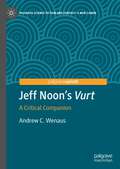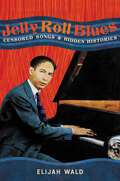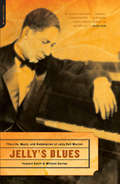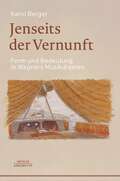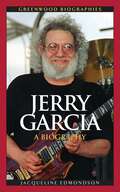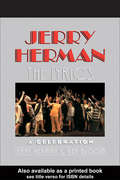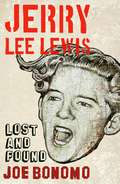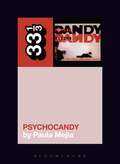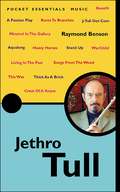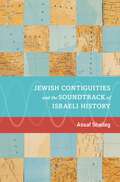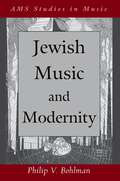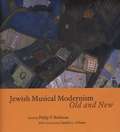- Table View
- List View
Jeff Noon's "Vurt": A Critical Companion (Palgrave Science Fiction and Fantasy: A New Canon)
by Andrew C. WenausThis book offers an examination of Jeff Noon’s iconoclastic debut novel, Vurt (1993). In this first book-length study of the novel, which includes an extended interview with Noon, Wenaus considers how Vurt complicates the process of literary canonization, its constructivist relationship to genre, its violent and oneiric setting of Manchester, its use of the Orphic myth as an archetype for the practice of literary collage and musical remix, and how the structural paradoxes of chaos and fractal geometry inform the novel’s content, form, and theme. Finally, Wenaus makes the case for Vurt’s ongoing relevance in the 21st century, an era increasingly characterized by neuro-totalitarianism, psychopolitics, and digital surveillance. With Vurt, Noon begins his project of rupturing feedback loops of control by breaking narrative habits and embracing the contingent and unpredictable. An inventive, energetic, and heartbreaking novel, Vurt is also an optimistic and heartfelt call for artists to actively create open futures.
Jeliya at the Crossroads: Learning African Wisdom through an Embodied Practice (Palgrave Studies in Literary Anthropology)
by Lisa FederThis book describes the remarkable culture of jeliya, a musical and verbal art from the Manding region of West Africa. Using an embodied practice as her methodology, the author reveals how she and her music teachers live “in between” local and global cultures. Her journey spans 20 years of fieldwork presented through personal and intimate stories, first as a student of the balafon instrument, then as a patron of the music. Tensions build in both the music and in social relations that require resolutions, underscoring the differences between two world views. Through balafon lessons, the author embodies values such as patience, courage, and generosity, resulting in a transformative practice that leads her to better understand her position vis-à-vis that of her jeli teachers. Meanwhile, jeliya itself, despite having been transmitted from teacher to student for 800 years, is currently in peril. Jelis cite modern globalized culture and people like the author herself as both a source of the problem as well as the potential solution.
Jelly Roll Blues: Censored Songs and Hidden Histories
by Elijah WaldA bestselling music historian follows Jelly Roll Morton on a journey through the hidden worlds and forbidden songs of early blues and jazz. In Jelly Roll Blues: Censored Songs and Hidden Histories, Elijah Wald takes readers on a journey into the hidden and censored world of early blues and jazz, guided by the legendary New Orleans pianist Jelly Roll Morton. Morton became nationally famous as a composer and bandleader in the 1920s, but got his start twenty years earlier, entertaining customers in the city&’s famous bordellos and singing rough blues in Gulf Coast honky-tonks. He recorded an oral history of that time in 1938, but the most distinctive songs were hidden away for over fifty years, because the language and themes were as wild and raunchy as anything in gangsta rap. Those songs inspired Wald to explore how much other history had been locked away and censored, and this book is the result of that quest. Full of previously unpublished lyrics and stories, it paints a new and surprising picture of the dawn of American popular music, when jazz and blues were still the private, after-hours music of the Black "sporting world." It gives new insight into familiar figures like Buddy Bolden and Louis Armstrong, and introduces forgotten characters like Ready Money, the New Orleans sex worker and pickpocket who ended up owning one of the largest Black hotels on the West Coast. Revelatory and fascinating, these songs and stories provide an alternate view of Black culture at the turn of the twentieth century, when a new generation was shaping lives their parents could not have imagined and art that transformed popular culture around the world—the birth of a joyous, angry, desperate, loving, and ferociously funny tradition that resurfaced in hip-hop and continues to inspire young artists in a new millennium.
Jelly's Blues: The Life, Music, and Redemption of Jelly Roll Morton
by Howard Reich William M. GainesJelly's Blues recounts the tumultuous life of Jelly Roll Morton (ca., 18851941). A virtuoso pianist with a larger-than-life personality, he composed such influential early jazz pieces as "King Porter Stomp" and "New Orleans Blues." However, by the late 1930s, he was nearly forgotten. In 1992, the death of an eccentric memorabilia collector led to the unearthing of a startling archive, revealing Morton to be a much more complex and passionate man than many realized. An especially immediate and visceral look into the jazz worlds of New Orleans and Chicago, Jelly's Blues is a definitive biography, a long overdue look at one of the twentieth century's most important composers.
Jenseits der Vernunft: Form und Bedeutung in Wagners Musikdramen
by Karol BergerKarol Berger setzt Wagners Musikdramen in Beziehung zu den philosophischen und kulturellen Ideen seiner Zeit und konzentriert sich dabei in einer ausführlichen und gut verständlichen Analyse auf die vier Werke, die dieser in der zweiten Hälfte seiner Karriere schuf: „Der Ring des Nibelungen“, „Tristan und Isolde“, „Die Meistersinger von Nürnberg“ und „Parsifal“. Der Autor versucht, in das Geheimnis der Großform von Wagners Musikdramen einzudringen und erzielt überraschende Ergebnisse wie die Nähe Wagners zur italienischen Oper. Bei seiner Einordnung der Musikdramen auf der ideologischen Landkarte seiner Zeit relativieren sich, ganz gegen des Autors ursprüngliche Absicht, viele Einwände von Wagners Kritikern, allen voran Nietzsche.
Jerry Garcia: A Biography (Greenwood Biographies)
by Jacqueline EdmondsonThis biography offers students and general readers an insightful look into Jerry Garcia's creative genius as a founding member of The Grateful Dead and the various influences on his work as he contributed to the countercultural movement in the United States.As a founding member of The Grateful Dead, Jerry Garcia became famous for his work as a key creative force in this band. Known for free flowing jam sessions, psychedelic drug use, and a loyal fan base, The Grateful Dead combined a variety of genres, including blues, folk and country rock to create new and different sounds than those used by other popular bands at the time, including The Rolling Stones and The Beatles. Garcia contributed significantly to an era in American music that was influenced by social changes, war, and political strife. Yet Garcia's creative genius expanded beyond the fame that came as lead guitarist and vocalist for the Dead. From the time he was a young boy learning to play the piano in the Excelsior district of San Francisco, Garcia explored various genres and forms of music and visual art. This biography offers students and general readers an insightful look into Garcia's creative genius and the various influences on his work as he contributed to the counter-cultural movement in the United States.
Jerry Garcia: A Biography (Greenwood Biographies)
by Jacqueline EdmondsonThis biography offers students and general readers an insightful look into Jerry Garcia's creative genius as a founding member of The Grateful Dead and the various influences on his work as he contributed to the countercultural movement in the United States.As a founding member of The Grateful Dead, Jerry Garcia became famous for his work as a key creative force in this band. Known for free flowing jam sessions, psychedelic drug use, and a loyal fan base, The Grateful Dead combined a variety of genres, including blues, folk and country rock to create new and different sounds than those used by other popular bands at the time, including The Rolling Stones and The Beatles. Garcia contributed significantly to an era in American music that was influenced by social changes, war, and political strife. Yet Garcia's creative genius expanded beyond the fame that came as lead guitarist and vocalist for the Dead. From the time he was a young boy learning to play the piano in the Excelsior district of San Francisco, Garcia explored various genres and forms of music and visual art. This biography offers students and general readers an insightful look into Garcia's creative genius and the various influences on his work as he contributed to the counter-cultural movement in the United States.
Jerry Herman: The Lyrics
by Jerry Herman Ken BloomJerry Herman is one of Broadway's most celebrated composers and lyricists, this book includes early lyrics from Herman's first Broadway revues and shows, songs cut from his best-loved shows, and new lyrics.
Jerry Herman: The Lyrics
by Jerry Herman Ken BloomJerry Herman is one of Broadway's most celebrated composers and lyricists, this book includes early lyrics from Herman's first Broadway revues and shows, songs cut from his best-loved shows, and new lyrics.
Jerry Lee Lewis: Lost and Found
by Joe BonomoA superb new study of Jerry Lee Lewis that's as intense and fast paced as the life of "The Killer" himself, from the height of fame to the bumpy road that followed"The category in which Jerry Lee Lewis truly belongs is 'Jerry Lee Lewis.' The Killer is as big as Mount Rushmore, and he's also as American, as revered, as clichéd, as misunderstood, as corny, and as taken for granted as that monument. The curse of iconoclastic American success. Elvis felt it, so does Dylan. So will others who haven't been born yet."The story of Louisiana hellcat Jerry Lee Lewis and his 1958 wedding scandal-it was discovered that at 22 he had married his 13-year old second cousin, Myra, before he was divorced from his second wife-long ago took precedence over the man himself and the music he makes. In Jerry Lee Lewis: Lost and Found, author Joe Bonomo lets others focus on the scandal and delves more deeply into the accidental intersection between fading American Rockabilly and ascending Beatlemania. By first taking a look at the critical years before his famed night in 1964 at West Germany's Star-Club - what that meant not only for him but the entire live album-making world - then the tumultuous years that follow, culminating in his time on the American Country charts in the late 60s/ early 70s, Bonomo brings Jerry Lee Lewis to life in new and fascinating ways.In spite of plummeting record sales and concert fees, a media savaging of his personal character, a change of record labels and management, and a considerable upturn in his drug and alcohol abuse, Jerry Lee Lewis has persevered. In between being betrayed and ignored, he would record one of the greatest rock & roll performances in history. Bonomo's thorough research includes new interviews with Live at the Star-Club producer Sigi Loch, members of the Nashville Teens, and other musicians and fans who were at the Star-Club performance, as well as with music industry figures ranging from famed Nashville producer Jerry Kennedy and legendary Memphis stalwart Jim Dickinson to Killer-influenced contemporaries John Doe and Dave Alvin. This passionate book examines and explains the almighty impact of the Father of Rock'n'Roll.
Jerry Lee Lewis: Lost and Found
by Joe BonomoA superb new study of Jerry Lee Lewis that's as intense and fast paced as the life of "The Killer" himself, from the height of fame to the bumpy road that followed"The category in which Jerry Lee Lewis truly belongs is 'Jerry Lee Lewis.' The Killer is as big as Mount Rushmore, and he's also as American, as revered, as clichéd, as misunderstood, as corny, and as taken for granted as that monument. The curse of iconoclastic American success. Elvis felt it, so does Dylan. So will others who haven't been born yet."The story of Louisiana hellcat Jerry Lee Lewis and his 1958 wedding scandal-it was discovered that at 22 he had married his 13-year old second cousin, Myra, before he was divorced from his second wife-long ago took precedence over the man himself and the music he makes. In Jerry Lee Lewis: Lost and Found, author Joe Bonomo lets others focus on the scandal and delves more deeply into the accidental intersection between fading American Rockabilly and ascending Beatlemania. By first taking a look at the critical years before his famed night in 1964 at West Germany's Star-Club - what that meant not only for him but the entire live album-making world - then the tumultuous years that follow, culminating in his time on the American Country charts in the late 60s/ early 70s, Bonomo brings Jerry Lee Lewis to life in new and fascinating ways.In spite of plummeting record sales and concert fees, a media savaging of his personal character, a change of record labels and management, and a considerable upturn in his drug and alcohol abuse, Jerry Lee Lewis has persevered. In between being betrayed and ignored, he would record one of the greatest rock & roll performances in history. Bonomo's thorough research includes new interviews with Live at the Star-Club producer Sigi Loch, members of the Nashville Teens, and other musicians and fans who were at the Star-Club performance, as well as with music industry figures ranging from famed Nashville producer Jerry Kennedy and legendary Memphis stalwart Jim Dickinson to Killer-influenced contemporaries John Doe and Dave Alvin. This passionate book examines and explains the almighty impact of the Father of Rock'n'Roll.
Jerry on Jerry: The Unpublished Jerry Garcia Interviews
by Trixie Garcia Dennis McNallyThese never-before-published interviews with Jerry Garcia reveal his thoughts on religion, politics, his personal life, and his creative process. Jerry on Jerry provides new insight into the beloved frontman of the Grateful Dead in time for the 50th Anniversary of the band.Released by the Jerry Garcia Family and made available to the public for the first time, these are some of the most candid, intimate interviews with Jerry Garcia ever published. Here, Garcia speaks openly about everything from growing up in the San Francisco Bay Area and his first encounters with early R&B to his thoughts on songwriting, LSD, the Beats and Neal Cassady, government, movies, and more. Illustrated with family photographs, ephemera, and Jerry's artwork, Jerry on Jerry presents uniquely poignant, unguarded, and astute moments, showing a side of Jerry that even his biggest fans have not known.
The Jesus and Mary Chain's Psychocandy (33 1/3)
by Paula MejiaThe Jesus and Mary Chain's swooning debut Psychocandy seared through the underground and through the pop charts, shifting the role of noise within pop music forever. Post-punk and pro-confusion, Psychocandy became the sound of a generation poised on the brink of revolution, establishing Creation Records as a tastemaking entity in the process. The Scottish band's notorious live performances were both punishingly loud and riot-spurring, inevitably acting as socio-political commentary on tensions emergent in mid-1980s Britain. Through caustic clangs and feedback channeling the rage of the working-class who'd had enough, Psychocandy gestures toward the perverse pleasure in having your eardrums exploded and loudness as a politics within itself. Yet Psychocandy's blackened candy heart center – calling out to phantoms Candy and Honey with an unsettling charm – makes it a pop album to the core, and not unlike the sugarcoated sounds the Ronettes became famous for in the 1960s. The Jesus and Mary Chain expertly carved out a place where depravity and sweetness entwined, emerging from the isolating underground of suburban Scotland grasping the distinct sound of a generation, apathetic and uncertain. The irresistible Psychocandy emerged as a clairvoyant account of struggle and sweetness that still causes us to grapple with pop music's relation to ourselves.
The Jesus and Mary Chain's Psychocandy (33 1/3)
by Paula MejiaThe Jesus and Mary Chain's swooning debut Psychocandy seared through the underground and through the pop charts, shifting the role of noise within pop music forever. Post-punk and pro-confusion, Psychocandy became the sound of a generation poised on the brink of revolution, establishing Creation Records as a tastemaking entity in the process. The Scottish band's notorious live performances were both punishingly loud and riot-spurring, inevitably acting as socio-political commentary on tensions emergent in mid-1980s Britain. Through caustic clangs and feedback channeling the rage of the working-class who'd had enough, Psychocandy gestures toward the perverse pleasure in having your eardrums exploded and loudness as a politics within itself. Yet Psychocandy's blackened candy heart center – calling out to phantoms Candy and Honey with an unsettling charm – makes it a pop album to the core, and not unlike the sugarcoated sounds the Ronettes became famous for in the 1960s. The Jesus and Mary Chain expertly carved out a place where depravity and sweetness entwined, emerging from the isolating underground of suburban Scotland grasping the distinct sound of a generation, apathetic and uncertain. The irresistible Psychocandy emerged as a clairvoyant account of struggle and sweetness that still causes us to grapple with pop music's relation to ourselves.
Jethro Tull: The Pocket Essential Guide (Pocket Essential Ser.)
by Raymond BensonThe Legendary Jethro Tull - How many rock bands from the sixties can you name that are still around today? Probably not that many. There are a couple — the Rolling Stones, Santana-but most have broken up, stopped recording, and reappear only for the ubiquitous 'reunion' tours. Jethro Tull is one band that formed in 1968 and are still going strong, thanks to the leadership, vision, and extraordinary talent of its leader, Ian Anderson. Named after the 17th Century inventor of the seed drill, Jethro Tull have always been controversial, challenging, and completely impossible to categorize. Are they rock? Blues? 'Progressive'? English folk? These labels merely begin to describe Jethro Tull's eclectic and imaginative music. Author Raymond Benson looks at this legendary rock band and analyzes their place in pop music history. He examines every Jethro Tull album—track listing, personnel, cover art, recording history, and content. A handy rating system informs Tull newbies where to start and provides longtime fans with fodder for debate. A book for both the casual and hard-core fan, Jethro Tull is an insightful companion to enhance one's listening pleasure.
Jewish Contiguities and the Soundtrack of Israeli History
by Assaf ShellegJewish Contiguities and the Soundtrack of Israeli History unfolds the cultural itineraries of modern Jewish and Israeli art music. Extending from modern Jewish art music in Europe through its dislocation to British Palestine and Israel, the book captures the tensions between national rhetoric and nationalized theological tropes through the way they have been recorded in art music. Author Assaf Shelleg begins with the prehistory of Israeli art music in central and Western Europe. He introduces the reader to the various aesthetic dilemmas in the history of modern Jewish art music, ranging from auto-exoticism to Jewish self-hatred. Moving on to consider the Hebrew culture, he discusses the institutionalization of art music in British Palestine and the dilution of romanticist nationalism during the interregnum of Israeli statehood. Delving into the proliferation of styles in the 1950s and '60s, Shelleg examines the collapse of traditional Hebrew templates and the concomitant surge of linear compositional devices inspired by Arab Jewish music. By the 1970s, he reveals, Israeli composers saw musical Judaism as a cultural discourse that transcended the nation; they deterritorialized the national discourse at the same time that religious Zionist circles had been translating theology into politics. Shelleg unearths the various cultural constraints and dialectics that played a pivotal role in the dislocation of modern Jewish art music to Israel, and looks at the Jewish undercurrents of Hebrew culture and how Jewish secularized concepts outgrew their national functions. Jewish Contiguities and the Soundtrack of Israeli History will be essential reading for scholars of Jewish and Israeli music, culture, and history
Jewish Music and Modernity (AMS Studies in Music)
by Philip BohlmanJewish Music and Modernity demonstrates how borders between repertories are crossed and the sound of modernity is enriched by the movement of music and musicians from the peripheries to the center of modern culture. Bohlman ultimately challenges readers to experience the modern confrontation of self and other anew.
Jewish Musical Modernism, Old and New
by Philip V. Bohlman Sander L. GilmanTackling the myriad issues raised by Sander Gilman’s provocative opening salvo—”Are Jews Musical?”—this volume’s distinguished contributors present a series of essays that trace the intersections of Jewish history and music from the late nineteenth century to the present. Covering the sacred and the secular, the European and the non-European, and all the arenas where these realms converge, these essays recast the established history of Jewish culture and its influences on modernity. Mitchell Ash explores the relationship of Jewish scientists to modernist artists and musicians, while Edwin Seroussi looks at the creation of Jewish sacred music in nineteenth-century Vienna. Discussing Jewish musicologists in Austria and Germany, Pamela Potter details their contributions to the “science of music” as a modern phenomenon. Kay Kaufman Shelemay investigates European influence in the music of an Ethiopian Jewish community, and Michael P. Steinberg traces the life and works of Charlotte Salomon, whose paintings staged the destruction of the Holocaust. Bolstered by Philip V. Bohlman’s wide-ranging introduction and epilogue, and featuring lush color illustrations and a complementary CD of the period’s music, this volume is a lavish tribute to Jewish contributions to modernity.
Jewish Musical Modernism, Old and New
by Philip Vilas Bohlman Sander L. GilmanTackling the myriad issues raised by Sander Gilman’s provocative opening salvo—”Are Jews Musical?”—this volume’s distinguished contributors present a series of essays that trace the intersections of Jewish history and music from the late nineteenth century to the present. Covering the sacred and the secular, the European and the non-European, and all the arenas where these realms converge, these essays recast the established history of Jewish culture and its influences on modernity. Mitchell Ash explores the relationship of Jewish scientists to modernist artists and musicians, while Edwin Seroussi looks at the creation of Jewish sacred music in nineteenth-century Vienna. Discussing Jewish musicologists in Austria and Germany, Pamela Potter details their contributions to the “science of music” as a modern phenomenon. Kay Kaufman Shelemay investigates European influence in the music of an Ethiopian Jewish community, and Michael P. Steinberg traces the life and works of Charlotte Salomon, whose paintings staged the destruction of the Holocaust. Bolstered by Philip V. Bohlman’s wide-ranging introduction and epilogue, and featuring lush color illustrations and a complementary CD of the period’s music, this volume is a lavish tribute to Jewish contributions to modernity.
Jews and Jazz: Improvising Ethnicity
by Charles B HerschJews and Jazz: Improvising Ethnicity explores the meaning of Jewish involvement in the world of American jazz. It focuses on the ways prominent jazz musicians like Stan Getz, Benny Goodman, Artie Shaw, Lee Konitz, Dave Liebman, Michael Brecker, and Red Rodney have engaged with jazz in order to explore and construct ethnic identities. The author looks at Jewish identity through jazz in the context of the surrounding American culture, believing that American Jews have used jazz to construct three kinds of identities: to become more American, to emphasize their minority outsider status, and to become more Jewish. From the beginning, Jewish musicians have used jazz for all three of these purposes, but the emphasis has shifted over time. In the 1920s and 1930s, when Jews were seen as foreign, Jews used jazz to make a more inclusive America, for themselves and for blacks, establishing their American identity. Beginning in the 1940s, as Jews became more accepted into the mainstream, they used jazz to "re-minoritize" and avoid over-assimilation through identification with African Americans. Finally, starting in the 1960s as ethnic assertion became more predominant in America, Jews have used jazz to explore and advance their identities as Jews in a multicultural society.
Jews and Jazz: Improvising Ethnicity
by Charles B HerschJews and Jazz: Improvising Ethnicity explores the meaning of Jewish involvement in the world of American jazz. It focuses on the ways prominent jazz musicians like Stan Getz, Benny Goodman, Artie Shaw, Lee Konitz, Dave Liebman, Michael Brecker, and Red Rodney have engaged with jazz in order to explore and construct ethnic identities. The author looks at Jewish identity through jazz in the context of the surrounding American culture, believing that American Jews have used jazz to construct three kinds of identities: to become more American, to emphasize their minority outsider status, and to become more Jewish. From the beginning, Jewish musicians have used jazz for all three of these purposes, but the emphasis has shifted over time. In the 1920s and 1930s, when Jews were seen as foreign, Jews used jazz to make a more inclusive America, for themselves and for blacks, establishing their American identity. Beginning in the 1940s, as Jews became more accepted into the mainstream, they used jazz to "re-minoritize" and avoid over-assimilation through identification with African Americans. Finally, starting in the 1960s as ethnic assertion became more predominant in America, Jews have used jazz to explore and advance their identities as Jews in a multicultural society.
The Jews-Harp in Britain and Ireland
by Michael WrightThe jews-harp is a distinctive musical instrument of international importance, yet it remains one of those musical instruments, like the ocarina, kazoo or even the art of whistling, that travels beneath the established musical radar. The story of the jews-harp is also part of our musical culture, though it has attracted relatively little academic study. Britain and Ireland played a significant role in the instrument‘s manufacture and world distribution, particularly during the nineteenth and first half of the twentieth centuries. Drawing upon previously unknown written sources and piecing together thousands of fragments of information spanning hundreds of years, Michael Wright tells the story of the jews-harp‘s long history in the Britain and Ireland. Beginning with an introductory chapter describing the instrument, Part One looks at the various theories of its ancient origin, how it came to be in Europe, terminology, and its English name. Part Two explores its commercial exploitation and the importance of the export market in the development of manufacturing. Part Three looks the instrument‘s appearance and use in art, literature and the media, finally considering the many players who have used the instrument throughout its long history.
The Jews-Harp in Britain and Ireland
by Michael WrightThe jews-harp is a distinctive musical instrument of international importance, yet it remains one of those musical instruments, like the ocarina, kazoo or even the art of whistling, that travels beneath the established musical radar. The story of the jews-harp is also part of our musical culture, though it has attracted relatively little academic study. Britain and Ireland played a significant role in the instrument‘s manufacture and world distribution, particularly during the nineteenth and first half of the twentieth centuries. Drawing upon previously unknown written sources and piecing together thousands of fragments of information spanning hundreds of years, Michael Wright tells the story of the jews-harp‘s long history in the Britain and Ireland. Beginning with an introductory chapter describing the instrument, Part One looks at the various theories of its ancient origin, how it came to be in Europe, terminology, and its English name. Part Two explores its commercial exploitation and the importance of the export market in the development of manufacturing. Part Three looks the instrument‘s appearance and use in art, literature and the media, finally considering the many players who have used the instrument throughout its long history.
Jews, Race and Popular Music
by Jon StrattonJon Stratton provides a pioneering work on Jews as a racialized group in the popular music of America, Britain and Australia during the twentieth and early twenty-first centuries. Rather than taking a narrative, historical approach the book consists of a number of case studies, looking at the American, British and Australian music industries. Stratton's primary motivation is to uncover how the racialized positioning of Jews, which was sometimes similar but often different in each of the societies under consideration, affected the kinds of music with which Jews have become involved. Stratton explores race as a cultural construction and continues discussions undertaken in Jewish Studies concerning the racialization of the Jews and the stereotyping of Jews in order to present an in-depth and critical understanding of Jews, race and popular music.
Jews, Race and Popular Music
by Jon StrattonJon Stratton provides a pioneering work on Jews as a racialized group in the popular music of America, Britain and Australia during the twentieth and early twenty-first centuries. Rather than taking a narrative, historical approach the book consists of a number of case studies, looking at the American, British and Australian music industries. Stratton's primary motivation is to uncover how the racialized positioning of Jews, which was sometimes similar but often different in each of the societies under consideration, affected the kinds of music with which Jews have become involved. Stratton explores race as a cultural construction and continues discussions undertaken in Jewish Studies concerning the racialization of the Jews and the stereotyping of Jews in order to present an in-depth and critical understanding of Jews, race and popular music.
